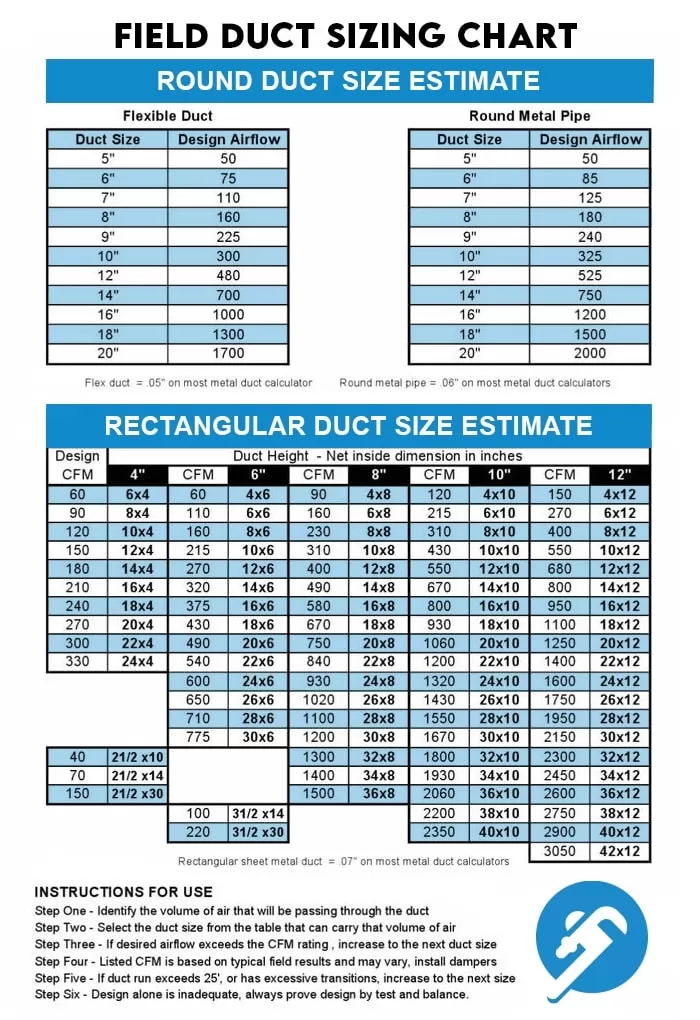Proper ventilation is essential for maintaining a comfortable and healthy indoor environment. When sizing ducts for a room, it is crucial to ensure that air circulation is efficient and effective. If you’re wondering what size duct you need for a 12′ x 12′ room, this guide will walk you through the steps to make an informed decision.
Remember, if you need ductwork or if you have other FAQs about duct and venting, you can lean on the experts here at PlumbersStock.
How to Calculate Duct Size (Simplified):

The first step in determining the appropriate duct size is to calculate the required airflow for the room. The airflow is usually measured in cubic feet per minute (CFM) and is determined by factors such as the room size, the intended use of the room, and the desired air changes per hour (ACH). A standard guideline for a typical residential room is to achieve 6-8 ACH.
For a 12′ x 12′ room, the volume would be Volume = Length x Width x Height Volume = 12 ft x 12 ft x Standard Ceiling Height (assume 8 ft) = 1152 cubic feet.
To calculate the required CFM for 6-8 ACH, use the following formula: Required CFM = Volume of the room x ACH / 60 minutes. If you do the math at 6 ACH, you’re at about 115 CFM. If you do the math at 8 ACH, you’re at about 153 CFM.
Also, you can simplify the math slightly if you want a rough estimate. The room’s square footage will tell you what the CFM should be (12 x 12 = 144).
The most important thing to remember is, “Always prove by testing and balancing.” Meaning, you can’t expect to perfectly plan the duct system, and there is often some adjustment on the back end.
Use Duct Sizing Charts:
Duct sizing charts are readily available online and in various HVAC manuals. These charts guide selecting the appropriate duct size based on the calculated CFM, duct material, and shape. To ensure accurate sizing, use the CFM value you calculated earlier and match it to the corresponding duct size on the chart.
A rectangular 4″ x 8″ duct rates around 120 CFM. That may not be enough. A 4″ x 10″ duct rates around 150 CFM. Consider many factors involved, and you may want to consult a professional. Remember how we mentioned simplifying the math to making CFM = square footage? That would’ve put you squarely in between these two vent-size options.
Choose the Appropriate Duct Material:
Ducts can be made from various materials, including metal, flexible duct board, and flex duct. The material you choose can impact the overall efficiency of the ventilation system. Metal ducts are durable and feature smooth interiors that minimize airflow resistance, making them a suitable choice for various applications. Flexible ducts are more convenient to install in tight spaces but may have higher airflow resistance.
Consider Duct Shape and Layout:
Ducts come in different shapes: round, rectangular, and oval. The form you choose can affect the airflow dynamics. Round ducts are generally more efficient for airflow than rectangular ones, as they minimize corners and reduce pressure drop. However, rectangular ducts might be more suitable if the installation space is limited.
Account for Static Pressure:

Static pressure refers to the resistance that air encounters as it moves through the duct system. Factors like duct length influence it, bends, and fittings. Choosing a duct size that considers static pressure is crucial for maintaining airflow. Oversized ducts can reduce air velocity, while undersized ducts can increase static pressure and reduce overall system efficiency.
Is There a More Granular Approach?
Yes. Duct size is more than just room size and airflow. You might need to consider how much resistance (friction) the air will face as it moves through the ducts.
“Duct sizing must be based on the friction rate derived from the available static pressure, length of the critical path, and the total effective length of all fittings.” – ACCA Manual D, Residential Duct Systems
Available Static Pressure (ASP)
This is the pressure your HVAC system has left to push air through the ducts after accounting for pressure lost to components like the coil and filter. Think of it like your “budget” of pressure.
Friction Rate
This indicates the amount of pressure lost per foot of duct due to air friction against the inside walls. Smaller ducts = higher friction. Larger ducts = lower friction.
Critical Path
The longest duct runs from the blower to the furthest room, including all turns and fittings. That’s the path that creates the most resistance, so the whole system is sized to handle that worst-case scenario.
Total Effective Length (TEL)
Not just the straight-line distance. You have to add equivalent lengths for every elbow, tee, and transition, because fittings slow airflow down.
Do I Have to Know the Friction Rate?
No. As we stated before, “Always prove the design through testing and balancing.” So, if you can’t figure out the Friction Rate, you can get it right on the back end.
Consult a Professional:
While using sizing charts and guidelines can provide a general idea of the appropriate duct size, consulting with a professional HVAC technician is recommended. They can consider factors specific to your situation, such as the type of HVAC system you have, the layout of your home, and any unique requirements. An HVAC professional can also perform more detailed calculations to ensure optimal performance.
In conclusion, selecting the correct duct size for a 12′ x 12′ room involves calculating the required airflow, choosing the appropriate duct material and shape, referencing duct sizing charts, and accounting for static pressure. While you can use guidelines and charts, seeking advice from an HVAC professional is the best way to ensure your ventilation system functions efficiently and maintains a comfortable indoor environment. Properly sized ducts improve air quality, energy efficiency, and overall well-being in your living space.
Resources:
Video: Quick and Easy Shortcuts
About the Author
Nathan is a product expert and has worked for PlumbersStock since 2012. Like many in the company, he's a graduate of Southern Utah University. He enjoys spending time with his family, the gym, being in the mountains, reading, movies, music, watching sports, and playing CoD online with his little brother.
